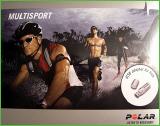
Performance Diagnostics
How fit are you really? A Polar OwnIndex® analysis determines your maximum oxygen uptake and gives you the answer!
Not only endurance athletes, but also more and more people who want to achieve extraordinary things in life know about the importance of their physical fitness and efficiency when it comes to reaching their goals.
When they train, most endurance athletes aim at increasing their fitness and their endurance performance. This increased performance does not necessarily have to be driven by the ambition to do well in a competition, though. The observation that the training has been effective creates motivation and important feedback on how to ideally design training units.
An increase in performance can be measured in many ways. On the one hand, the subjective perception may show that doing physical activities becomes easier over time. On the other hand the increased performance can be measured objectively. It is possible, for example, to note down how long it takes to run a certain distance. If the fitness level rises, the distance can be run in less time. Another possibility is to undergo performance diagnostics. In spiroergometry, minute ventilation and gas exchange (O2 uptake and CO2 output) is measured alongside heart rate and blood pressure.
Measuring the oxygen uptake during maximum exercise (VO2max) enables the perception of an individual performance level. The higher the VO2max level is, the more oxygen is absorbed through the lungs, transported by the blood and ultimately used as energy supply.
To exactly determine the VO2max, maximum exercise is by definition always needed. But for a long time now, it has been attempted to determine this level without exercise. This benefits a routine application as well as a determination of the performance level of untrained persons or persons with health impairments. To make this indirect analysis possible, formulas and traditional parameters (age, sex, and weight) are used.
OwnIndex analysis with Polar RS 800 GPS
The Polar OwnIndex fitness test also uses those parameters and additionally integrates new factors, such as heart rate and heart rate variability, to gain even more specific results.
Procedure
The conduct of OwnIndex should be standardised. This means that the test takes place at a fixed time under constant conditions (at rest, lying in bed, as relaxed as possible). To get a basic figure all future measures can relate to, it is recommended to do the OwnIndex fitness test each morning for a week. In the course of further training, 2 – 4 week analyses give a good review over the development of the performance level.
Interpretation
The maximum oxygen uptake, just like other fitness test results, is most significant if figures and alterations are compared individually. For that, during the course of training, the athlete looks at individual alterations in relation to the basic figure acquired before.
Limitations of the Polar OwnIndex®
The Polar OwnIndex fitness test was created for healthy adults. Independent, comparative figures in the table range from age 20 to 65. That means that for these age groups, reverence factors can be used. Younger and older athletes can therefore use the table as an orientation only. They should pay more attention to their individual interpretation, because, due to their specific age, no universal statement can be made for them. It is especially recommended for older people to have their performance level tested by a doctor on a regular basis to ascertain possible illnesses and age-related constraints early on and to give ideal training recommendations.
People suffering from chronic diseases or taking medication that affect heart rate or blood pressure can use OwnIndex solely for individual interpretations. Due to the alteration of the heartrate or heart rate variability, a comparison with results of the total population is impossible. That is why for these athletes, training recommendations should not be based on the OwnIndex. These recommendations should in any case be given by a doctor or experienced sports scientist with the help of an endurance test.
The OwnIndex analysis can be conducted at the ASI Akademie and at the practices in Munich and Murnau.